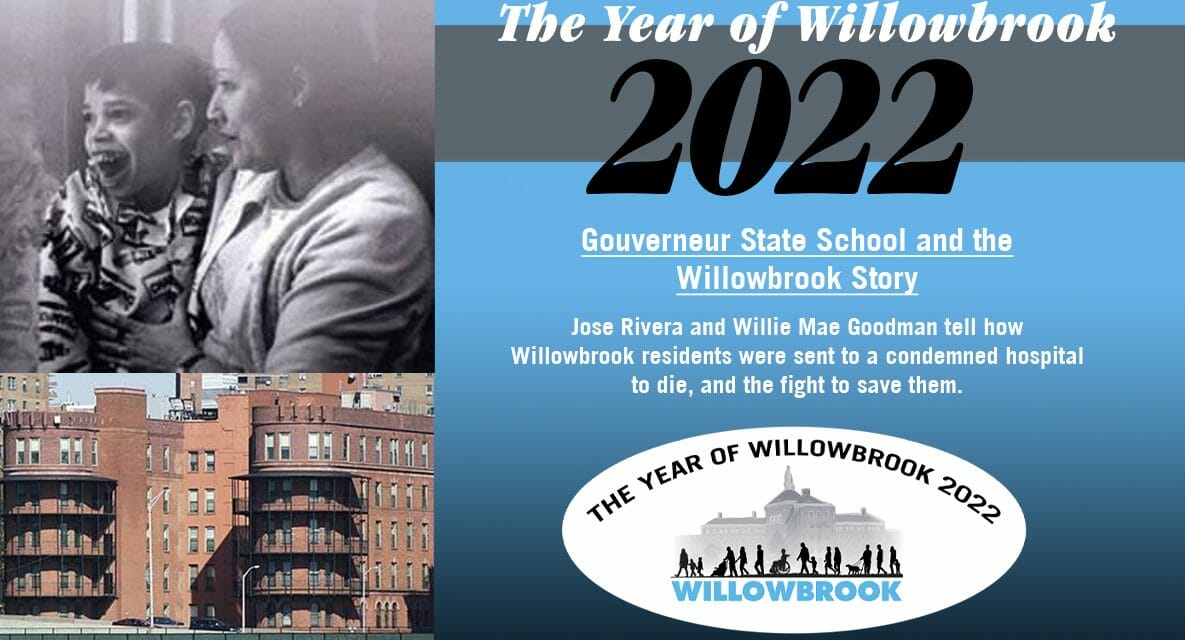Jose Rivera and Willie Mae Goodman tell how Willowbrook residents were sent to a condemned hospital to die, and the fight to save them.
As part of the 2022 Year of Willowbrook at the College of Staten Island, the Willowbrook Legacy Project will present “Gouverneur State School and the Willowbrook Story,” a look into how Gouverneur Hospital, deemed as an “outmoded and inadequate” structure by the City of New York, became a home to hundreds of profoundly disabled residents after the Willowbrook closure, left there to die while parents and advocates fought to save them. The event will take place virtually on Zoom on Wednesday, June 15, at 6pm, and will feature Jose J. Rivera, brother of a former Gouverneur resident and Gouverneur Parent Association member, as well as Willie Mae Goodman, whose suit against New York State resulted in the 1971 injunction that ordered New York State to establish care for their children in a setting that respected their essential human rights, in conversation with Willowbrook Legacy Project Co-chair Dr. Catherine Lavender, Professor of History, The College of Staten Island/CUNY, with commentary from Professor Jorge Matos Valldejuli, of Hostos Community College/CUNY.
In 1962, in an effort to relieve overcrowding at Willowbrook, the New York State Department of Mental Hygiene began quietly transferring about 200 children and infants with severe disabilities from Willowbrook to the former Gouverneur Hospital in Manhattan’s lower East Side. The vast majority of the children transferred to Gouverneur were non-verbal and non-ambulatory persons with profound needs for care. The Department of Mental Hygiene had determined that these children had a short life expectancy, due to the severity of their disabilities. The expectation that the placement would be short-term freed officials to use the “obsolete and dilapidated” building despite its being condemned.
In telling this story, the Willowbrook Legacy Project has worked closely with the families associated with Gouverneur, especially Rivera and Goodman, who will tell their story and illustrate the paucity of care available outside of Willowbrook, as well as the limits on the rights of its residents and their parents. Before the 1972 class action lawsuit that eventually yielded the Consent Judgement that closed Willowbrook, the parents of children sent to Gouverneur turned to the courts to intervene on their behalf. This led to court injunction in 1971.
The Gouverneur story is about the survival of human beings who had been abandoned by the care system and placed in a building vacated by the City as uninhabitable. The Gouverneur story is about the apathy by State officials who failed to provide the Gouverneur residents with the rehabilitative services they required. It is a story about the deep advocacy by families to ensure the survival of their loved ones, about partnerships, among families, direct care staff, journalists, and the community that proved a formidable alliance in preventing the State, via a court injunction, from transferring the Gouverneur residents back to Willowbrook in 1971. This was but a prelude to the Willowbrook class-action law suit filed in 1972 and the subsequent deinstitutionalization of thousands across New York State and tens of thousands across the country.
The event is free and registration is open. It will also be captured on video and will be made available through the Willowbrook YouTube channel.
For more information about The Year of Willowbrook, visit their Website.
About Willowbrook State School and The Willowbrook Mile
Willowbrook State School was the largest institution in the world in which people with disabilities were locked away from society. In 1938, the New York State Legislature had authorized the building of a school for what they then termed “mental defectives.” The Willowbrook site was selected and the buildings erected in the early 1940s. However, when the U.S. entered the Second World War, the site was turned over to the military for use as a hospital and prisoner-of-war camp, Halloran Hospital, and operated in that capacity until 1951. As Halloran Hospital was closing down, the property returned to its original intended purpose as the Willowbrook State School. It opened in 1947, intended to serve as a model of treatment for persons with intellectual and other disabilities.
When it opened, Willowbrook attempted to provide better care in an institutional setting than could be provided at home. However, the mere scope and size of the more-than-380-acre Willowbrook State School impaired its ability to provide normal, personalized comfort and care. As conditions worsened, a group of residents’ families and staff urged change. By the 1970s, they invited reporters to share the story more widely. Media coverage and this activism led to a lawsuit resulting in a 1975 Consent Judgement ordering that Willowbrook residents receive humane treatment and adequate clinical and educational services. This also set in motion the eventual closure of Willowbrook in 1987 and began the development of community-based services. Along with the 1975 Education for All Handicapped Children Act, the Willowbrook Judgement helped lead to later key legal protections, including the 1990 Americans with Disabilities Act (ADA).
In the early 1990s, spurred by a conviction that nothing like the Willowbrook story should ever happen again, the Staten Island Developmental Disabilities Council, the primary advocacy group on Staten Island for persons with disabilities and their families, formed the Willowbrook Property Planning Committee. They began to work on collecting and preserving the history of the Willowbrook State School and to increase the visibility of the stories of those who had once lived and worked in the facility.
In the 2010s, the Staten Island Developmental Disabilities Council partnered with the other stakeholders on the Willowbrook site: the College of Staten Island/CUNY, the Institute for Basic Research (IBR), and the Office for People with Developmental Disabilities (OPWDD) – to establish a memorial walking trail that has become the Willowbrook Mile. The Mile is designed to preserve the site’s history, and to create a visionary presence that commemorates the social justice and deinstitutionalization movement to ensure the rights of all persons to live with dignity and thrive in their communities.


![Is this a [contemporary [syntax book]] or a [[contemporary syntax] book]*? Prof’s new book introduces syntax to beginning students](https://csitoday.com/wp-content/themes/Extra/images/post-format-thumb-text.svg)













